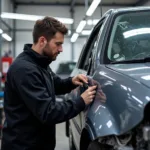Flaking paint on a car is more than just an eyesore; it’s a sign of underlying issues that can worsen if left untreated. This comprehensive guide will delve into the causes, solutions, and preventative measures for repairing flaking paint on your car, helping you restore its appearance and protect its value.
Understanding the Causes of Flaking Car Paint
Why does car paint flake in the first place? Several factors contribute to this unsightly problem, ranging from environmental factors to improper painting techniques. Understanding these causes is crucial for effective repair and prevention. Common culprits include prolonged exposure to sunlight (UV rays), harsh weather conditions like extreme temperatures and salt, and even bird droppings, which are acidic and can etch into the paint. Poor quality paint jobs, inadequate surface preparation before painting, and even minor accidents can also lead to flaking.
Sometimes, the issue isn’t just the top coat; rust underneath the paint can cause it to bubble and flake. Identifying the root cause is essential for choosing the right repair method. Is it simply age and weathering, or is there a deeper issue like rust that needs addressing?
Here’s a breakdown of common causes:
- Sun Damage: UV rays break down the paint’s chemical bonds.
- Moisture: Water seeps under the paint, causing it to lift and flake.
- Rust: Corrosion underneath pushes the paint outward.
- Poor Paint Job: Inadequate preparation or low-quality paint can lead to premature flaking.
- Impact Damage: Stone chips and other impacts can create weak points where flaking begins.
DIY Repair vs. Professional Help: Which is Right for You?
Deciding whether to tackle the flaking paint yourself or seek professional help depends on the severity of the damage and your comfort level with car repair. Minor flaking on a small area might be manageable with a DIY approach, while extensive flaking or rust damage often requires professional expertise. For minor repairs, you might consider repair minor paint damage for a car.
Assessing the Damage and Choosing the Right Approach
Before making a decision, carefully assess the extent of the flaking. Is it confined to a small area, or is it widespread? Is there rust present? These questions will guide you towards the best course of action. For instance, you might find resources on how to repair flaking car paint helpful for DIY repairs. However, for more complex issues like cracked paint, a professional might be necessary.
Steps to Repair Flaking Car Paint
If you decide to tackle the repair yourself, follow these steps:
- Clean the Area: Thoroughly wash and dry the affected area.
- Remove Loose Paint: Gently scrape away any loose or flaking paint using a plastic scraper or sandpaper.
- Sand the Surface: Smooth the area with fine-grit sandpaper.
- Prime the Area: Apply primer to protect the bare metal and provide a better surface for the paint to adhere to.
- Apply Paint: Apply several thin coats of automotive paint, allowing each coat to dry before applying the next.
- Clear Coat (Optional): Apply a clear coat for added protection and shine.
If you’re dealing with cracked paint, especially on the bumper, you might find our guide on repair cracked paint on car bumper helpful. Similarly, for more general cracked paint issues, cracked paint on car repair might offer useful information.
Preventing Future Flaking
Prevention is key to maintaining a vibrant car finish. Regular washing and waxing can protect the paint from environmental damage. Parking in a garage or using a car cover can shield your car from harmful UV rays and weather elements. Addressing minor chips and scratches promptly can prevent them from developing into larger areas of flaking.
John Smith, an automotive paint specialist with over 20 years of experience, advises, “Regular waxing is like sunscreen for your car’s paint. It creates a protective barrier against the sun’s harmful UV rays.” Another expert, Sarah Jones, a certified auto body technician, adds, “Addressing minor paint chips immediately can prevent rust from forming and save you from more extensive repairs down the road.”
Conclusion
Repairing flaking paint on car is essential for preserving its appearance and protecting it from further damage. By understanding the causes, choosing the right repair method, and taking preventative measures, you can keep your car looking its best for years to come. Don’t let flaking paint diminish your car’s value – address it promptly and effectively. If you’re looking for specialized car paint repair services, you might consider car paint repair sheffield north if you happen to be in that area.
FAQ
-
What type of paint should I use for touch-ups? Use automotive touch-up paint that matches your car’s color code.
-
Can I repair flaking paint in cold weather? It’s best to repair paint in moderate temperatures for proper drying and adhesion.
-
How often should I wax my car? Waxing every three to six months is generally recommended.
-
What kind of sandpaper should I use? Start with a coarser grit (e.g., 220) and gradually move to finer grits (e.g., 1500) for a smooth finish.
-
Can I paint over rust? You should remove all rust before painting for a lasting repair.
-
How long does it take for touch-up paint to dry? Drying times vary, but generally allow at least 24 hours for complete drying.
-
How much does professional paint repair cost? The cost depends on the extent of the damage, but expect to pay several hundred dollars or more.
Need help with car diagnostics or complex repairs? Our team is available 24/7. Contact us via WhatsApp: +1(641)206-8880, or Email: [email protected]. We’re here to help!


